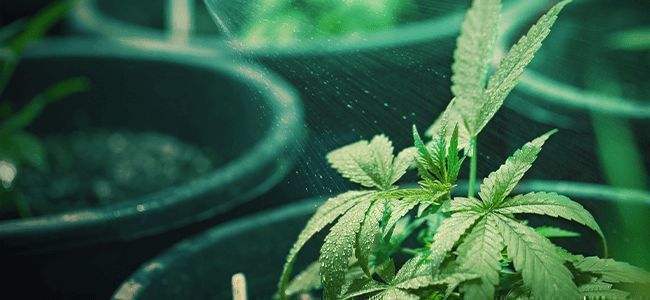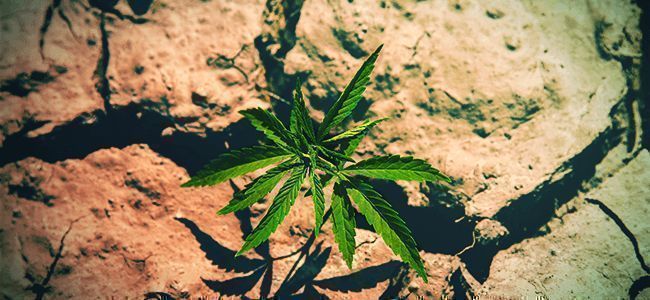How Much Water Do Cannabis Plants Need?
Just as with humans, cannabis plants need water to survive and thrive. But too much - or too little - and they die. Finding the right balance is crucial for an abundant harvest.
80% of the weight of the living plant is water. This amount of fluid is required to transport the nutrients from the soil throughout the plant and for temperature regulation through transpiration. Less than 1% of the water absorbed is broken down to provide hydrogen, which is, along with carbon dioxide, used to form carbohydrates during photosynthesis. The remaining water diffuses up to the foliage, where the actual transpiration takes place. This process is called the transpiration stream - if it comes to a halt, the leaves will wilt and the plant gradually dies.
How do you know when the cannabis plant needs water - and how much?

There is no fixed rule about when and how much plants need water. As convenient as that would be, simple differences in geographical location and gardening circumstances make this impossible. A plant in the northern parts of Europe might need only 2 Liters every 3 days, as the soil preserves the humidity well. The same plant in Spain might need three times as much water, as the sun dries out the soil quickly. Then consider the soil itself. If it is a fast draining soil, it obviously needs to be replenished more often. Clay soils drain very slowly, and overwatering can occur quickly.
You can easily test the drainage of your soil by digging a 30 cm hole and pouring water in it. If it takes under one minute to drain, you have good soil. If it takes 1 hour, your soil is compacted or clay, which means it needs to be replaced or improved. But there are more factors to consider. For example, the size of the plant, the size of the pot (if any at all), temperature, humidity, air circulation and if the plant is in vegetation or flowering.
So, instead of figuring out a formula that takes all factors into account, it’s much easier to look at the visual signs the plant gives you. As soon as the lower foliage shows the slightest sign of diminishing resilience and slackens, she is in need for a good sip of water. But ideally it shouldn’t come that far - if you want to be a caring daddy to your green girls, you won't wait for that sign, but rather provide them with enough water beforehand.
As a rule of thumb, when the soil about 5cm deep feels dry, water slowly until the soil is evenly moisturized. This works well for plants directly in the soil, as well as for plants in a pot. When using a pot, make sure that there is only very little water running out the drainage holes to prevent loss of nutrients. After a few trials you will know approximately how much water the pot can hold before excess water runs out. Always water around the stem, avoid to get it wet - this decreases the likelihood of stem rot.
Never allow the soil to become too wet or too dry

Over-watering is the number one mistake when growing cannabis. It can become a huge problem quickly - cannabis cannot tolerate a saturated or sopping wet soil. It is vital for the root system to get enough oxygen, but that cannot happen when there is too much water in the soil, as no air reaches the roots and the plant suffocates. A plant in poor draining soil grows slower, is usually less potent and prone to attacks from root and stem rot. If the problem persists for too long, the plants die.
Under-watering is less of a problem - since it is easily recognized, it can be corrected immediately. As mentioned above, the first sign is when the lower foliage droops; if you don't water now, the condition will work its way up the plant until the top bends over.
Water temperature and daytime

Always use lukewarm water; it soaks into the soil more easily and will not shock the roots. Always water from the top of the pot - never submerge the pot in a bucket or tub, for then the water displaces the soil's oxygen and the plant will grow poorly.
As for the right time of the day; it depends on your climate and your availability of water. Generally, it is best to water during the morning hours, so the plants have all day long to work with the water. But if you live in a hot climate and you need to preserve water, it is possible to water in the evening. This will prevent the water from evaporating quickly.
A simple way to prevent quick evaporation in hot climates is to use some sort of mulch. The purpose of a mulch layer is to preserve humidity. A simple and easy way to do so is by covering the soil around the plant with flattened brown cardboard. It doesn't rot easily and will make sure the soil stays humid for much longer.
The ideal water for cannabis
It is possible to make a science out of the water quality, but if your tap water is decent, your plants will be fine. But of course, there is always something to improve.
It goes without saying that the water should be free from chlorine and other harmful chemical substances. While chlorine usually is not really a problem for the plant itself, it can have a negative effect on the symbiotic microorganisms in the soil.
Water for cannabis plants should have a balanced pH level. It is best to get a simple digital pH meter to determine the exact level of your water source. During vegetation, cannabis prefers a pH level between 5.6 and 5.8, during flowering a level between 6.0 and 6.2. You can easily correct the pH level with plant friendly formulas found in your garden store.

Natural sources of water can work well, but they can vary greatly in their pH level. Water from rivers tends to be more basic, water from stagnant sources more acidic. Clean rainwater has a pH of around 5.6 and is a very good choice for watering your cannabis plants as it is a rich source of nitrogen.
If you want to take it even a step further, you can aerate your water with a cheap aquarium air pump for 24 hours. Aeration will increase the oxygen content of the water, which is very beneficial for the roots and overall plant health. Plus, during aeration chlorine will naturally escape the water, which will leave the micro-organisms alive. You can also aerate the soil naturally, either by using up to 25% of perlite in your soil mix, or by simply letting the soil go on the dry side before watering again.
-
 5 min
5 May 2025
Simple tips to grow better weed
Think growing great weed is hard? With a few essential weed-growing tips and some basic know-how, anyone can enjoy top-shelf harvests in any setup. Get acquainted with eight essential tips for...
5 min
5 May 2025
Simple tips to grow better weed
Think growing great weed is hard? With a few essential weed-growing tips and some basic know-how, anyone can enjoy top-shelf harvests in any setup. Get acquainted with eight essential tips for...
-
 3 min
31 July 2019
How To Adjust pH Level When Growing Cannabis
In this article, we’ll teach you all you need to know about the importance of pH when growing cannabis, and how to change your pH levels if necessary.
3 min
31 July 2019
How To Adjust pH Level When Growing Cannabis
In this article, we’ll teach you all you need to know about the importance of pH when growing cannabis, and how to change your pH levels if necessary.
-
 5 min
27 September 2018
What Is The Best Water For Cannabis Plants?
Nothing can be more important for successful cannabis growing than water quality and the proper watering technique. Learn about the best water for your cannabis plants!
5 min
27 September 2018
What Is The Best Water For Cannabis Plants?
Nothing can be more important for successful cannabis growing than water quality and the proper watering technique. Learn about the best water for your cannabis plants!





 United States
United States












